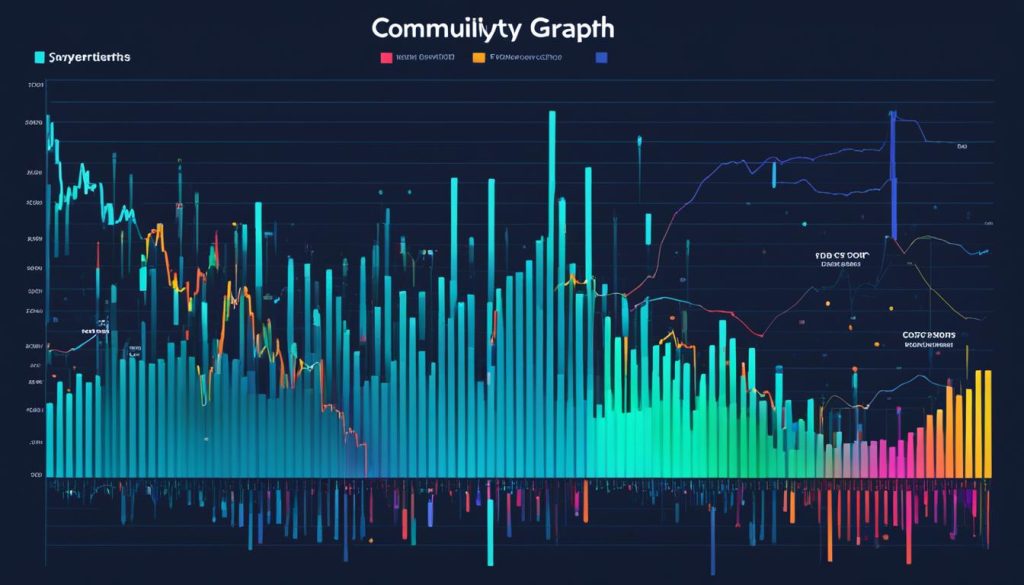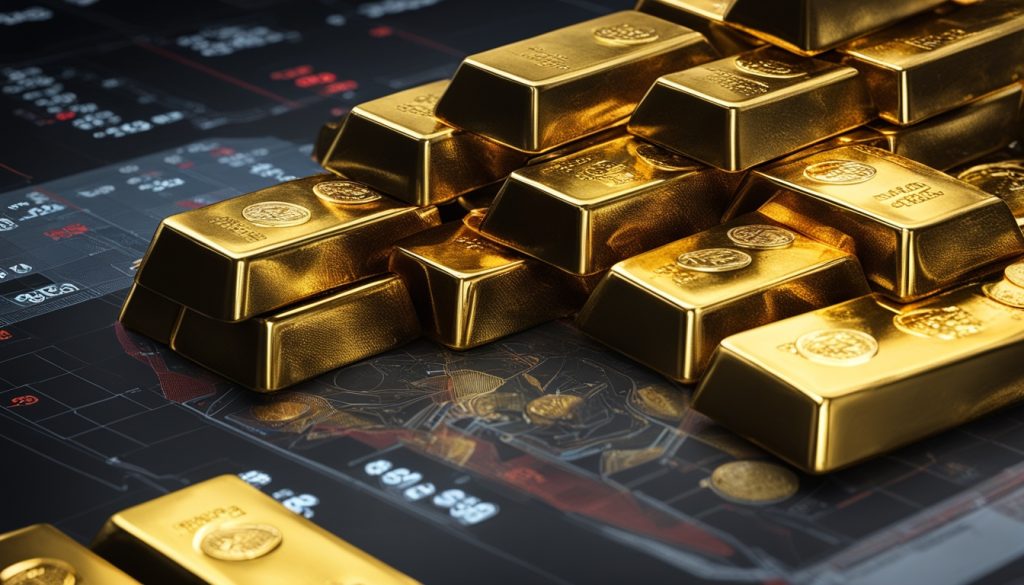Commodities include things like oil, gas, and coal, as well as food items like corn and soybeans. They also cover precious metals like gold and silver1. These items have simple financial tools for trading and follow clear market rules1. Investing in them can help diversify your portfolio and protect against price changes in some industries2. This article will look into the main commodities and how they can meet your investment goals.
Key Takeaways
- Commodities include energy, metals, and agricultural products that are widely traded on global markets.
- Investing in commodities can offer diversification and protection against inflation2.
- Commodity trading can be done through physical ownership, futures contracts, or company stocks1.
- Mutual funds, ETFs, and ETNs provide diversified commodity exposure for investors3.
- Commodities can be volatile due to supply, demand, and other market factors1.
What are Commodities and Commodity Investing?
Commodities are raw materials and goods that people use or process and sell again. Examples include gold, oil, wheat, cattle, and aluminum4. They are split into energy products, agricultural products, and precious metals4. Investing in them can help diversify your portfolio, protect against inflation, and offer big returns5.
Definition and Examples of Commodities
Commodities are goods that can be easily swapped and traded worldwide6. Common ones are crude oil, natural gas, gold, silver, copper, wheat, corn, and soybeans4. These items are key for many industries and are vital to the world economy.
Benefits of Investing in Commodities
- Portfolio Diversification:5 Commodity funds often move differently than the stock market, making them great for spreading out your investments5.
- Inflation Hedge:5 When prices go up, commodity prices usually do too, making them a good defense against inflation5.
- Potential for Growth:4 The prices of commodities change based on supply and demand, offering chances for investors to make money54.
But, investing in commodities can also be risky because their prices can swing a lot56.
“Commodities can be a valuable addition to a diversified investment portfolio, offering exposure to a wide range of raw materials and potential growth opportunities.”
How to Invest in Commodities
Investing in commodities offers several options. One way is to own physical assets like gold and silver7. But, this method has its own issues, like storage and insurance.
Another path is futures contracts. These are deals to buy or sell a commodity at a set price later7. Futures trading lets investors use leverage but also brings big risks.
Physical Ownership
Buying physical commodities like gold and silver means you own the real thing7. It’s great for those wanting a solid asset during tough economic times. Yet, it has its downsides, like keeping it safe and selling it easily.
Futures Contracts
Futures contracts are another way to invest in commodities7. They let investors buy or sell a commodity at a set price later. Futures cover many commodities, from energy to metals. They offer big potential gains but also come with more risk than owning the asset itself.
Choosing between physical ownership and futures contracts depends on your goals and how much risk you can handle7. Both can be part of a well-rounded portfolio. But, it’s important to know the risks and benefits of each.
Individual Securities for Commodity Exposure
To get into the commodity market, investors can look at companies that work with commodities. These companies are often in the energy and basic materials sectors. Think of oil and gas firms, mining companies, and those that produce agriculture8.
This way of investing needs a good grasp of the industry’s details. Things like how much a company can produce, its global reach, and the balance between supply and demand affect its success and stock price8.
Investing in these stocks gives a direct link to certain commodities or sectors. But, it demands a lot of research and analysis to do well. Investors must look closely at the strengths and weaknesses of these companies. They also need to see where they stand in the commodity world8.
| Commodity-Related Stocks | Examples |
|---|---|
| Energy Sector | Exxon Mobil, Chevron, BP, Shell |
| Mining Companies | Newmont, Barrick Gold, Rio Tinto, BHP |
| Agricultural Producers | Archer-Daniels-Midland, Bunge, Cargill |
Investing in these stocks means understanding the industry well. It’s key to analyze and research carefully. This helps in finding the best investment chances in the commodity market8.
Mutual Funds, ETFs, and ETNs for Commodity Investing
Investors looking to tap into commodities without the need for physical assets or futures trading can turn to commodity-focused mutual funds, ETFs, and ETNs9. These products collect money from investors to invest in various commodities. They often use futures contracts, options, or shares in companies that produce commodities. Some funds also offer leveraged or inverse exposure to commodity prices9.
Commodity-Focused Investment Products
Commodity ETFs have expense ratios between 0.50% and 1.00%, depending on the fund and the commodity9. As of October 2023, ETFs focused on gold and silver are among the biggest in the market9. ETFs for oil and natural gas trade futures contracts rather than the actual commodities9. Some ETFs use strategies like laddering or optimization to reduce the negative effects of futures market contango9.
Leveraged and Inverse Commodity Funds
Leveraged commodity funds aim to increase the impact of commodity price changes, using futures contracts9. These funds usually have higher expense ratios than their non-leveraged peers9. On the other hand, inverse commodity funds aim to make money when commodity prices fall. This can help investors hedge their bets or speculate on price drops9. It’s worth noting that commodity ETFs can affect futures prices through their trading, which can change market prices9.
Commodity ETFs make it easy for investors to get into a variety of commodities. Commodity mutual funds and ETNs offer more ways to diversify a portfolio10. By doing thorough research and picking the right products, investors can meet their goals for commodity investments10.

In summary, commodity-focused mutual funds, ETFs, and ETNs give investors many ways to enter the commodities market. They offer benefits like diversification, liquidity, and risk management910.
Alternative Commodity Investments
Traditional commodity investments focus on raw materials like oil and gold. But, there’s a special group of investments that are more like collectibles11. These include precious metals like jewelry and coins, which can be worth more than their metal value11.
Precious Metals and Collectibles
Precious metals like gold are valuable for more than just their use. They also have beauty and history11. People who like these items see them as a special kind of investment. Their value can change based on more than just the metal’s price11.
For instance, rare jewelry and special coins can be worth a lot more than their metal. This is because they are rare, in good condition, or have cultural importance11. These items let investors add variety to their portfolios and might offer unique benefits11.
But, these investments have risks too12. Investors need to know about the challenges of buying, keeping, and selling these items. They should also think about taxes and rules12.
Investing in precious metals and collectibles is an exciting choice for those looking to go beyond usual markets1112.
“Investing in precious metal collectibles can provide a unique avenue for diversifying one’s portfolio and potentially benefiting from the nuances of the collectibles market.”
commodity investments, precious metals, commodity market
Investing in commodities like gold and silver can add value to your portfolio13. These metals are often traded along with oil and base metals13. They can protect your wealth when inflation hits, as they don’t move like stocks or bonds5. This makes them a smart choice for fighting inflation5.
Precious metals, especially gold, don’t usually move with other investments like stocks14. This makes them a great choice for spreading out your investments14. They can lower the risk in your portfolio14. Gold is seen as a safe bet and a way to protect against rising costs13. Also, when central banks buy more gold, it can push up its price13.
The market for commodities offers many ways to invest, from owning metals to futures contracts13. Metals like aluminum and copper are key for many industries and their prices can go up with global demand13. But, owning these metals might not make much money because they’re not very expensive13. ETFs like the SPDR S&P Metals & Mining ETF let you invest in companies that work with these metals13.
While commodities can help diversify your investments and protect against inflation, they also have risks5. Their prices can change a lot, which can be tough for investors5. There are risks like political and economic issues, foreign currency changes, and the challenges of finding new resources5. It’s key to think about these risks when adding commodities to your investment plan.
| Commodity | Key Characteristics |
|---|---|
| Crude Oil | Reacts to the laws of supply and demand; the U.S. is the largest net producer13 |
| Gold | Traditionally considered a safe investment and a hedge against inflation; central bank buying can affect prices13 |
| Base Metals | Used in commercial and industrial applications; prices impacted by rising global demand13 |

“Precious metals have diversified drivers of demand resulting in low overall correlations to the broader market and economic cycle.”
Risks and Considerations for Commodity Investing
Commodity investing can offer benefits like diversification and protection against inflation15. But, it also comes with big risks that investors need to think about15. The prices of commodities change a lot because of supply and demand shifts. These changes are affected by things like the weather, global economic trends, and climate15.
Volatility and Price Fluctuations
Commodity prices can go up and down fast, which can be tough for investors15. Investing in commodities means you could see big price changes because of how supply and demand balance in their markets15. This makes it hard to guess how much you’ll make and manage risks.
Supply and Demand Factors
Commodity prices mainly depend on supply and demand15. Things like political events, weather, and the world’s economy can change how much people want commodities and how much is available15. Investors need to watch out for these things that can change commodity prices a lot15.
Also, the risk of getting the actual commodity, not getting income from it, and big price changes make investing in commodities hard15. Before adding commodities to their portfolios, investors should think about how much risk they can handle and what they want to achieve15.
Even though commodities can offer diversification and protect against inflation, the risks need to be understood and managed well1516. Investors should get advice from experts and do their homework before deciding how commodities fit into their investment plans.
“Investing in commodities offers diversification from traditional assets like stocks and bonds, with low correlation to stock market movements.”15
| Commodity | Potential Demand Growth | Key Characteristics |
|---|---|---|
| Copper | Demand could double by 203516 | Essential for infrastructure development, growing demand due to energy transition16 |
| Gold | N/A | Historically considered a safe-haven asset16 |
| Silver | N/A | Provides hedging benefits and has industrial applications16 |
Conclusion
The world of17 commodity investments, especially precious metals, is a great way to diversify your portfolio and protect against inflation. Billions of dollars are traded daily in precious metals, showing their big economic role17. Gold, silver, platinum, and palladium17 are seen as solid choices for keeping wealth safe and stable18.
By investing in17 commodities, you can spread out your investments and reduce risks. These metals are good at17 protecting against inflation and economic ups and downs. They are a favorite for those looking for stability. Plus, studies show that19 during tough market times, precious metals can help diversify your portfolio.
But remember, investing in commodities comes with its own set of risks. You need to think about your investment goals, how much risk you can handle, and how commodities fit into your financial plan. Knowing the risks and benefits of17 commodity investments helps you make smart choices. This way, you can meet your financial goals and17 follow your investment strategy.
FAQ
What are commodities and how can they be used for investing?
Commodities are raw materials and goods that people use or turn into other products. Examples include gold, oil, wheat, cattle, and aluminum. Investing in them can help diversify a portfolio and protect against inflation. It also offers the chance for big returns.
How can investors gain exposure to commodities?
Investors can own commodities like gold and silver directly or through futures contracts. They can also invest in companies that work with these materials. Options include mutual funds, ETFs, and ETNs that focus on commodities.
What are the risks and considerations of commodity investing?
Investing in commodities, especially gold and silver, can be risky due to their volatile prices. These prices change based on supply and demand and outside factors like global events and weather. Investors should think about these risks before adding commodities to their investments.
Source Links
- What Are Commodities, and How To Invest in Them – NerdWallet
- Understanding Commodities | PIMCO
- How to Invest in Commodities
- What Is Commodity Investing? – Fidelity
- What are commodity funds? | BlackRock
- Commodities: The Portfolio Hedge
- Why and How to Invest in Commodities | U.S. Bank
- Parametric Commodity Strategy Fund (I) (EIPCX)
- Commodity ETF: Meaning, Overview, and Guide
- Commodity ETFs
- What are alternative investments? | Vanguard
- Alternative Investments: Commodities, Private Equity, & More
- 3 Commodities to Invest in
- Precious metals’ place in the portfolio
- Why is it Risky to Invest in Commodities?
- Why You Shouldn’t Ignore Investing in Commodities
- What is Precious Metal Commodity Trading & How Does it Work?
- Investing in Gold Commodity | World Gold Council
- The role of precious metals in portfolio diversification during the Covid19 pandemic: A wavelet-based quantile approach

